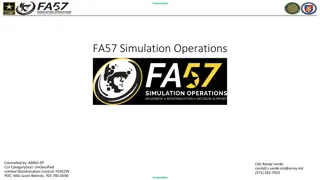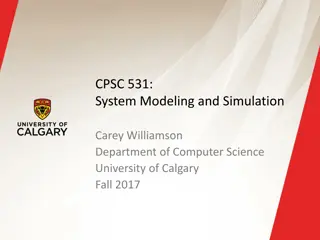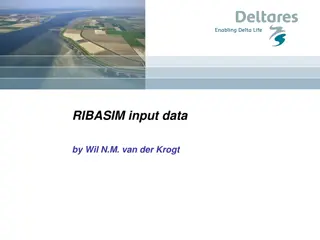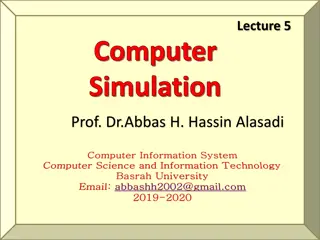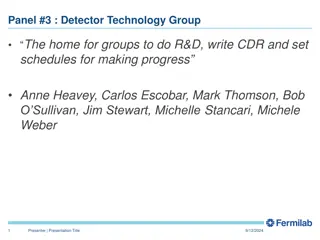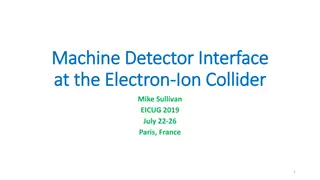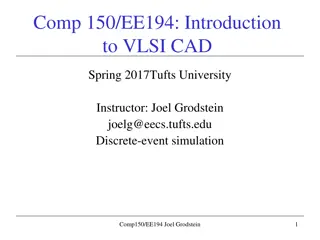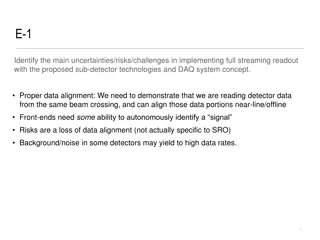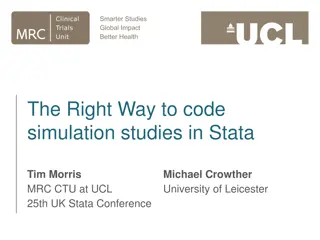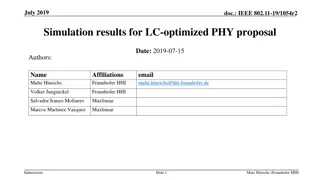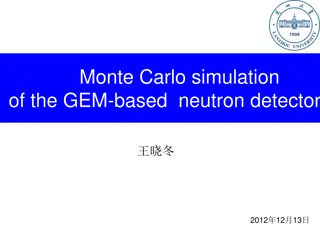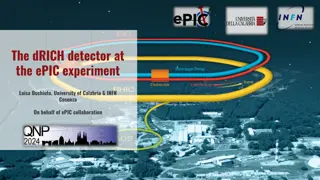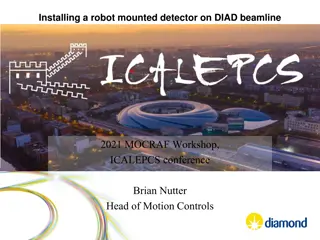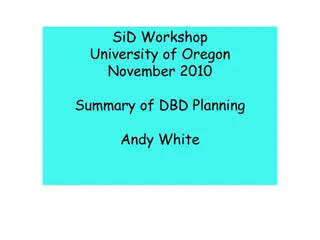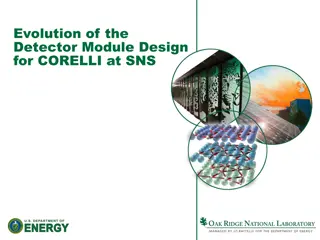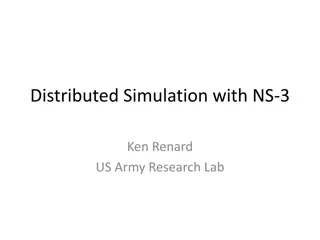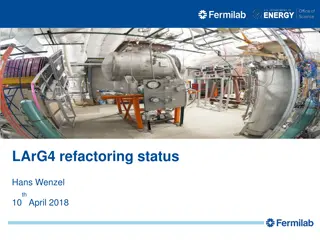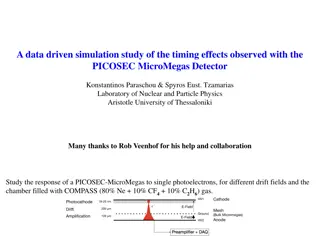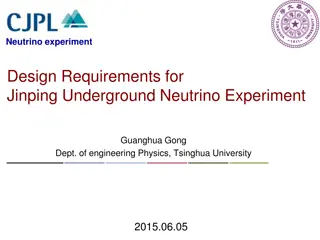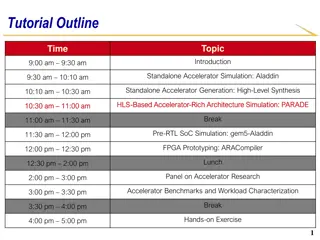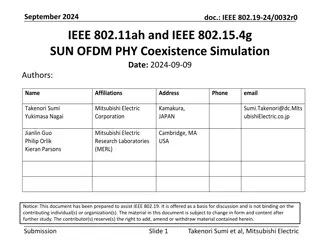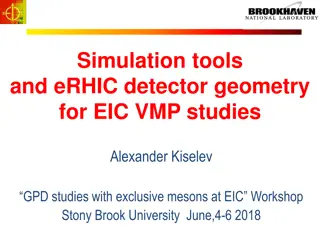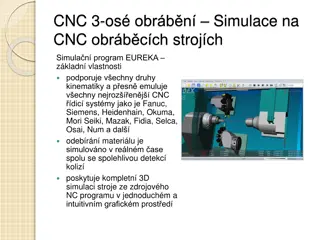Overview of Army Modeling and Simulation Office
The U.S. Army Modeling and Simulation Office (AMSO) serves as the lead activity in developing strategy and policy for the Army Modeling and Simulation Enterprise. It focuses on effective governance, resource management, coordination across various community areas, and training the Army Analysis, Mod
3 views • 8 slides
Monte Carlo Transport Simulation
Monte Carlo simulation is a stochastic technique that uses random numbers and probability statistics to investigate and solve problems. In the context of transport simulation, a Monte Carlo program simulates the passage of particles through matter, involving geometry, transport, visualization, detec
4 views • 11 slides
System Modeling and Simulation Overview
This content provides insights into CPSC 531: System Modeling and Simulation course, covering topics such as performance evaluation, simulation modeling, and terminology in system modeling. It emphasizes the importance of developing simulation programs, advantages of simulation, and key concepts lik
4 views • 28 slides
Basin Manipulation Simulation Analysis Tool Overview
Basin Manipulation Simulation Analysis Tool provides a comprehensive solution for managing and analyzing basin data, including tasks like basin manipulation, simulation analysis, case management, and defining simulation time steps. The tool allows for easy data entry, visualization of simulation res
11 views • 17 slides
Computer Simulation and Modeling Tools
Computer simulation and modeling is essential for conducting studies in various fields. Selecting the right simulation language or package is crucial for accurate results. This involves considering the characteristics of the language, such as random number generation, process transformers, list proc
5 views • 7 slides
Detector Technology Group: Research & Development Strategies
The Detector Technology Group focuses on R&D for detector technology, setting schedules to make progress. Discussions include short-term approaches for describing detectors, collaboration participation, and decision-making. Activities at CERN and Fermilab are reviewed to address any missing R&D area
0 views • 8 slides
Innovative n-Type Segmented Inverted Coaxial HPGe Detector Study
Comprehensive characterization of an n-type Segmented Inverted Coaxial Point Contact (ICPC) detector by Heather Crawford at the AGATA-GRETINA collaboration meeting. The study focuses on energy resolution, drift time corrections, azimuthal angle and full position reconstruction, along with in-beam ch
0 views • 29 slides
Challenges and Considerations in Electron-Ion Collider Detector Development
Exploring the development of detector systems for Electron-Ion Colliders (EIC) involves addressing various issues such as detector acceptance for low Q2 and high Q2, unique beam characteristics, and the need for specialized components like bend magnets and polarimeters. Key considerations include po
1 views • 16 slides
Introduction to VLSI CAD and Discrete-Event Simulation at Tufts University
This course introduces students to event-oriented simulation, building virtual models, and validating designs through simulation. It covers the importance of simulation in testing and refining designs before implementation. Examples include simulating VLSI networks and exploring the use of discrete-
5 views • 32 slides
Detector Response in SIDIS He3 Experiment
Introduction to analyzing hit and occupancy rates from different particle sources in the SIDIS He3 experiment. Explore the simulation data to determine event rates based on detector channels. Examples include pi0 sources and eDIS from the target. Various occupancy cuts are applied, and thresholds ar
1 views • 22 slides
Challenges and Common Solutions in Implementing Full Streaming Readout for Sub-Detector Technologies
Implementing full streaming readout with proposed sub-detector technologies and DAQ system concept poses challenges including proper data alignment, risks of data loss, and background noise affecting data rates. The transition point for electronic components from detector-specific to common solution
4 views • 9 slides
The Right Way to Code Simulation Studies in Stata
Simulation studies in Stata involve using (pseudo) random numbers to generate data from a distribution for studying statistical methods. This process helps to evaluate different scenarios and understand the properties of statistical techniques. Key components like ADEMP (Aims, Data-generating mechan
12 views • 18 slides
Simulation Results for LC-Optimized PHY Proposal in July 2019
The document presents simulation results for an LC-optimized PHY proposal for TGbb based on G.9991 PHY. It includes details on the simulation setup, frame detection results, header modulation, coding simulation results, payload modulation, and coding simulation results. The setup involved various re
3 views • 18 slides
Monte Carlo Simulation of GEM-Based Neutron Detector and Detector Performance Analysis
A detailed exploration of Monte Carlo simulations for GEM-based neutron detectors, investigating their detection efficiency and performance characteristics. Various detector designs and concepts, including multi-layer converters and GEM detectors, are discussed, along with simulation results on sign
3 views • 12 slides
Performance Studies of dRICH Detector at ePIC Experiment
The Electron-Ion Collider ePIC experiment focuses on the performance studies of the dRICH detector for particle identification crucial in various physics channels. The detector features aerogel optimization, SiPM sensors, and test-beam analyses. Key capabilities include different techniques for part
12 views • 28 slides
Installation of Robot-Mounted Detector on DIAD Beamline
Installing a robot-mounted detector on the DIAD beamline for the 2021 MOCRAF Workshop at the ICALEPCS conference. The robot arm holds a diffraction detector for dual imaging and diffraction purposes, ensuring safety for personnel, equipment, and integration into EPICS and GDA systems. Functionality
0 views • 28 slides
Overview of SiD Workshop Summary and DBD Planning
The SiD Workshop at the University of Oregon in November 2010 focused on the Summary of DBD Planning by Andy White. Key points covered included the timeline from Fall 2007 to End 2012, the Detailed Baseline Design DBD with nine crucial points, guidance for DBD presenters, and the importance of final
3 views • 29 slides
Optimizing ILD Detector for ILC: Goals & Deliverables
The focus is on optimizing the ILD detector for the ILC project to strengthen the physics case, demonstrate performance, and show complementarity with other projects like LHC. Goals include making the science case robust, defining a cost-effective ILD detector, and delivering key results. Deliverabl
1 views • 22 slides
Evolution of CORELLI Detector Module Design
This article discusses the evolution of the detector module design for CORELLI at SNS, detailing the challenges faced, working solutions, and the unique features of the Corelli instrument. From outlining the talk to the instrument layout and detector array specifications, the advancements in detecto
4 views • 21 slides
Distributed Simulation with NS-3
Explore the world of distributed simulation with NS-3 as presented in "Distributed Simulation with NS-3" by Ken Renard from the US Army Research Lab. Get insights into the application of NS-3 in creating advanced simulations for military research and beyond. Dive into the details of distributed simu
1 views • 38 slides
Probabilistic Simulation Approach for Data Centers at BM@N Facility
Predictive modeling of data storage and processing centers at the BM@N detector involves a probabilistic simulation approach to optimize detector geometry. By simulating information processes as byte streams and determining probabilities of data loss, the study aims to identify hardware configuratio
0 views • 17 slides
Efficiency Improvement in L0 Performance Simulation Using Primitives Alignment
In the L0 performance simulation scenario presented, the alignment of primitives from detectors within timeslots plays a crucial role in enhancing trigger efficiency. Timeslot width expansion to accommodate measurement errors and the impact of detector primitive alignment on resolution are discussed
1 views • 10 slides
Requirements for LArG4 Refactoring Status and Simulation Enhancement
Refactoring the LArG4 module includes separating simulation from digitization and detector response, optimizing CPU and memory efficiency, accessing physics lists, and improving simulation capabilities. The refactored SimDriftElectrons module enhances simulation features. Explore the physics use and
5 views • 15 slides
Timing Effects in PICOSEC-MicroMegas Detector Study
This study explores the response of a PICOSEC-MicroMegas detector to single photoelectrons under various drift field conditions. The chamber is filled with COMPASS gas (80% Ne, 10% CF4, 10% C2H6). The timing effects observed in the detector are analyzed through data-driven simulations, shedding ligh
4 views • 24 slides
Real-Time Simulation Executive for DARTS Lab Course
The Dynamics and Real-Time Simulation (DARTS) Laboratory is developing an exemplar simulation executive for their 2023 course. The simulation aims to create a dynamic vehicle assembly, set up data logging, run simulations in real-time, and render related models. The project outlines requirements, go
5 views • 42 slides
Innovative Neutrino Experiment Design Requirements at Jinping Underground Site
This project outlines the design requirements for the Jinping Underground Neutrino Experiment, focusing on physics requirements, detector concepts, target mass considerations, and major detector components. The experiment aims for a fiducial mass greater than 1Kt with an energy range of 0.1MeV to 10
0 views • 17 slides
Accelerator-Rich Architecture: Research Tools and Simulation Techniques
Explore a comprehensive agenda covering various aspects of accelerator-rich architecture, from standalone simulation to FPGA prototyping. Key topics include Aladdin simulation, High-Level Synthesis (HLS) generation, PARADE architecture simulation, gem5-Aladdin SoC simulation, and more. Join the disc
1 views • 29 slides
Simulation Modeling for Decision Support
This module focuses on developing skills in modeling and simulation of business dynamics to aid decision-making, utilizing simulation software for discrete-event simulation and System Dynamics. The course includes lectures, practical exercises, group coursework, and essays to enhance students' under
0 views • 37 slides
IEEE 802.19-24 Simulation Update for Coexistence of IEEE 802.15.4g and IEEE 802.11ah
Explore the simulation update for the coexistence of IEEE 802.15.4g and IEEE 802.11ah in the September 2024 document. The study focuses on smart utility use cases, presenting simulation parameters, performance metrics, and the background of the study. Dive into the details of simulation models, depl
2 views • 14 slides
Advanced Simulation Tools and Detector Geometry for EIC Studies
Explore the utilization of simulation tools and eRHIC detector geometry for EIC VMP studies and GPD studies with exclusive mesons. Discover the BeAST main detector geometry, EicRoot framework, available functionality, and simulation usage options for comprehensive insights into experimental physics
0 views • 16 slides
DARTS Lab: Simulation Objects, Data Access, and DVar Layer
Explore the Dynamics and Real-Time Simulation (DARTS) Laboratory's run-time data access, simulation objects, DVar documentation, and the importance of the DVar layer in providing standardized access to rich data for simulation objects. Discover the significance of this layer in decoupling services f
3 views • 21 slides
Cutting-Edge CNC Simulation Software for Machining Excellence
Discover EUREKA simulation software, a versatile tool for CNC machining simulation with advanced features supporting various kinematics and precise emulation of top CNC control systems. Experience real-time material simulation, collision detection, and complete 3D machine simulation in an intuitive
2 views • 12 slides
Insights from A601 AGATA-Like Detector Characterisation
This study explores the characterisation and efficiency evaluation of the A601 AGATA-like detector, providing valuable insights for enhancing detector performance and reliability in nuclear structure studies. The research delves into the unique specifications, testing procedures, and efficiency meas
1 views • 17 slides
Electron-Ion Collider Detector Proposals and Resource Requests
The EIC has published the Yellow Report and CDR, with collaborations forming for detector proposals. A Computing Working Group has been established to manage simulation resources. Resource requests have been made by ECCE and ATHENA for CPU and storage estimates to meet the short deadline for detecto
3 views • 7 slides
Investigation on SYNC Detector False Alarms in IEEE 802.11-18/1551r0
Explore the study on SYNC detector false alarms in IEEE 802.11-18/1551r0 focusing on the correlation between WUR payload and SYNC, alternative SYNC detector designs, threshold selection impact, and simulation results for HDR data to address high SNR false alarms effectively.
0 views • 9 slides
Cutting-Edge Developments in Calorimetry and Detector Technology
Explore innovative research in calorimetry and detector technology, including cost-effective scale-up calorimeters, advanced scintillators, new materials for calorimetry, and front-end electronics needs for high-energy resolution and picosecond timing. Discover the latest advancements in photon dete
5 views • 7 slides
Detector Development Process and Event Generation Overview in SiD Workshop
Explore the goals and processes involved in the SiD Workshop, focusing on detector development and event generation for physics analyses. Learn about simulation, reconstruction, tracking, and performance optimization strategies for the global system design. Stay updated on the latest advancements in
2 views • 27 slides
Development of High Granular Neutron Time-of-Flight Detector
Learn about the progress in the development of the High Granular Neutron Time-of-Flight Detector at Fedor Guber's lab in Moscow. Supported by RSF grant, the detector's structure, components, simulation results, and future plans are detailed in this informative update. Explore the proposed detector s
0 views • 19 slides
Enhanced Aerogel RICH Detector in Endcap Region
Discover how the updated detector scheme increases space for the aerogel detector up to 300 mm. Learn about the principles of particle identification and the momentum range extension with proximity focusing RICH counter. Find out about the optimum values for optimal refractive indices and photon det
0 views • 21 slides
Incremental Preliminary Design and Safety Review of EIC Detector DAQ
Detailed closeout report on the incremental preliminary design and safety review of the EIC Detector DAQ and electronics, along with the final design review of electronics components for the ePIC Detector. The report covers technical performance requirements, detector electronics and data acquisitio
0 views • 23 slides
